- Telephone
- Email
Cairns’ best reef trips to avoid seasickness – if you are looking at this page, then our guess is you are worried about getting seasick on your Great Barrier Reef trip, and we know all about it. Julie Johnston gets seasick and we’ve just recently discovered that Ethan Johnston is also prone to seasickness, especially if it’s particularly rough. So we know there’s nothing worse than being seasick when you are at the reef, it can ruin your whole day; we’ve been there and unfortunately, done that. However, don’t panic, there are a range of options available to help you manage your motion sickness, and still have the very best time on your Cairns reef tour. This includes preventative medication, picking the ‘right boat’ or choosing the ‘best reef tour’ to minimize the impacts of the motion of the ocean. Let’s dive right in ….
Important Note: This is our guide on Cairns’ best reef trips to avoid seasickness. It is based on our personal experiences, not only with the medications, but having traveled on all the boats and done all the Cairns reef tours in a range of seasons and weather. We cannot guarantee this will work for everyone, but it does work for us, and we genuinely want you to have the very best day and experience possible on the wonderful Great Barrier Reef, so we hope this is helpful.
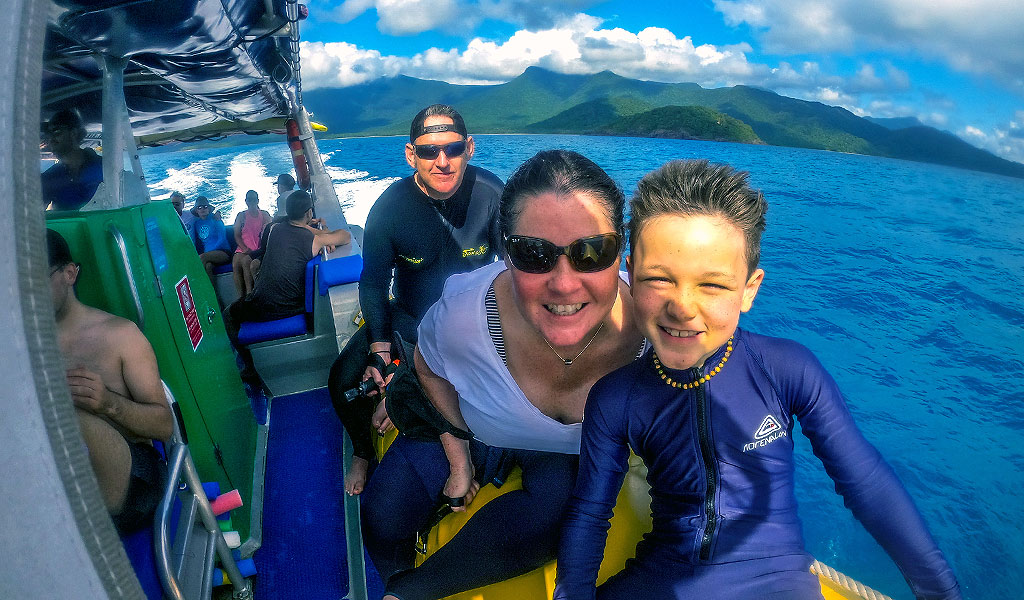
Seasickness can come on at any time and age. Don’t let it ruin your day on the Great Barrier Reef.
Seasickness is a form of motion sickness. Anyone can get it, but women are more susceptible than men and if you suffer from migraines, vertigo or vestibular issues, then you are also more susceptible to getting seasickness. It is caused by real or perceived motion, when there is an imbalance between actual versus expected sensory inputs and your eyes, inner ear and body all send conflicting messages to your brain. The symptoms can be debilitating to say the least. Cold sweats, nausea and vomiting and headache. They may persist for your entire time at sea or may reduce when the boat stops moving. In good news – there are a range of medication and options available to help you manage your motion sickness, and still have the very best time on your Great Barrier Reef tour.
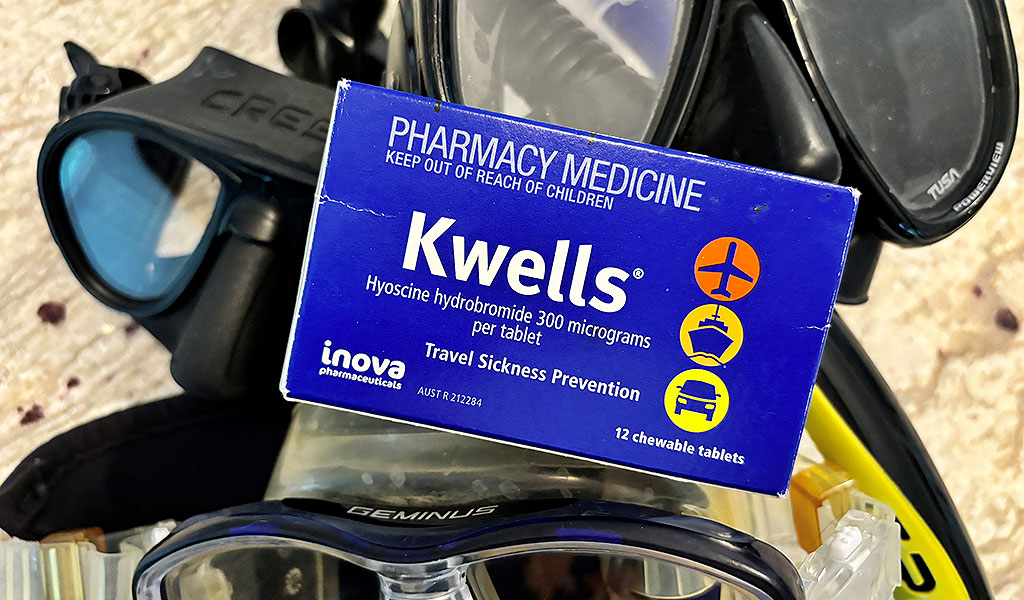
Preventative medication can help manage and prevent seasickness. There’s a range of options available.
Kwells is the best medication for seasickness (in our opinion) and is 100% our go to, to avoid getting seasick. Julie has been successfully using these for years and they have worked every time! In Australia you do not need a script to get these. Kwells can be purchased from most pharmacy and chemists across Cairns and the country. They are available for Adults and Children and are chewable tablets. They are preventative and should be taken at least 30 minutes prior to getting on the boat. These tablets are suitable for all forms of travel sickness (boat, car, bus, train or plane). The active ingredient is hyoscine hydrobromide. If you are aged over 65 years or are pregnant, there may be risks surrounding this and you should seek medical advice. There are some side effects, most notably Julie gets a really dry mouth (which is not awesome when scuba diving, but better than vomiting) and they can make you tired. Otherwise, we stand by Kwells as being really effective.
TravaCalm has a range of products that support people with motion sickness. Let’s break them down. TravaCalm Original and TravaCalm H.O are very similar to Kwells and have the same active ingredient, hyoscine hydrobromide. Like Kwells these tablets should be taken at least 30 minutes before getting on a boat, and can be purchased at most chemists. You do not need a medical / doctor prescription to get them. Julie has not taken Travacalm, but we would imagine it has similar side effects and precautions as Kwells and as highlighted above. Pro Tip: Always consult your doctor before taking any medication, especially if you have pre-existing conditions or are taking other medications.
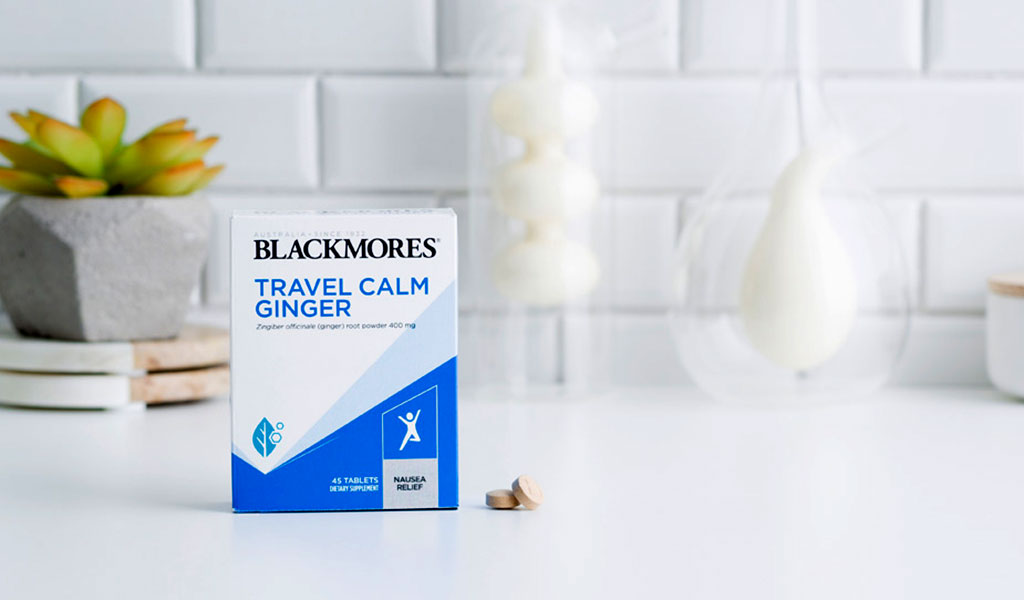
Natural Remedies for seasickness include ginger tablets and acupressure bands.
Some people do not feel comfortable or want to take medication for seasickness, especially pregnant ladies. If you are one of those people, then there are still a few options available to you. Ginger tablets can help alleviate the symptoms of seasickness, specifically nausea and are non-drowsy. Generally speaking, ginger tablets only benefit people who experience mild seasickness and there are quite a few products available, including TravaCalm Ginger and Blackmores Travel Calm Ginger. You don’t need a script to get these and they can be purchased in most chemists and pharmacies. A lot of the Cairns reef boats also have ginger tablets available to purchase on the boat, but if in doubt best take your own.
Travel bands are another option for drug free relief of motion sickness nausea. Travel bands use acupressure to activate key points on your wrist. They usually come in pairs and should be worn on both wrists. Again, travel bands generally benefit people who experience mild seasickness. There are a few different brands out there, including TravaCalm Travel Bands and Blooms the Chemist, Travel Comfort Bands.
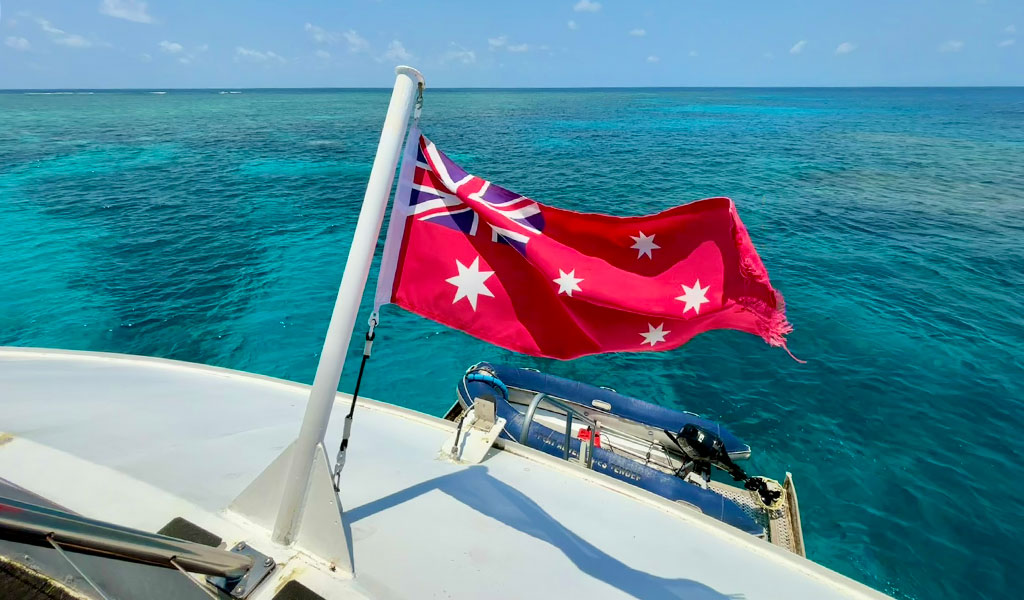
Not all boats are created equal when it comes to handling choppy seas. Here are the best options for a comfortable ride.
Rightyo. Here’s a most asked question. What are the best Cairns reef boats to minimize your risk of getting seasickness? Firstly, we want to preface the answer, by saying that all of the Cairns reef boats are custom built reef tourism boats. There’s no ‘bad boats’ and when Cairns has glass out days, with big blue skys and flat seas, all of the boats are in play. However, if you do get seasick and/or are worried about the weather and your day, then there are some boats we would recommend over others. The best Cairns reef boats to minimize your risk of getting seasick are Ocean Freedom, Silverswift (Quicksilver) and AquaQuest (Divers Den).
The best Port Douglas reef boats to minimize your risk of getting seasickness are Silversonic (Quicksilver), Calypso Reef Cruises and a little further north at Cape Tribulation you have Ocean Safari. We’ve been on all of these boats and they provide the most stable ride to the reef, in all conditions.
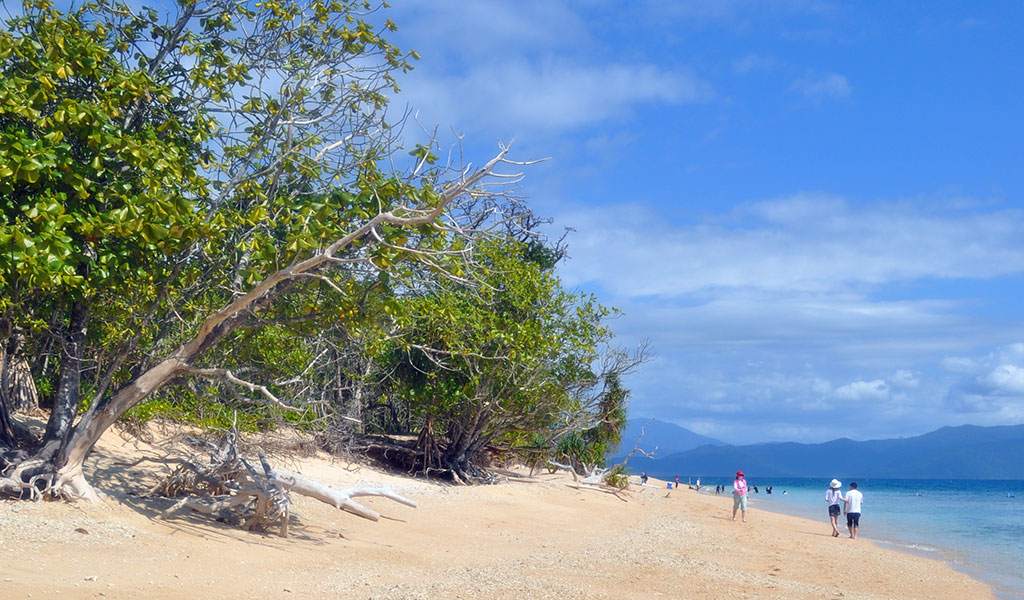
Different reef tour options for those that suffer seasickness - yes there are a few, we’ve got you covered.
If having read all of this, you are still worried about getting seasick when you visit the reef, there’s a few more options. We’re talking islands, pontoons and scenic helicopter flights. We’ll start with islands and there’s a few from Cairns, you’ve got Green Island, Fitzroy Island and the Frankland Islands. The shortest open water crossing – at just 10km – is on the Frankland Islands day tour. This tour starts 44km south of Cairns, but they provide coach transfers and the islands are lovely (pictured above). Green Island would be second on the ‘safe’ list – 27km open water crossing – with Fitzroy Island third (29km open water crossing); the transfer time to Green Island and Fitzroy Island are the same, but Fitzroy Island is around a headland and can be more ‘choppy’. Obviously in all of these instances, any seasickness you may be feeling should resolve when you get to the island.
Outer reef pontoons are another great option for those worried about seasickness, as they provide a stable base, when you get there. The reef around the pontoons is usually ‘better’ than that around the islands and there’s a range of activities when you get there, including snorkelling and scuba diving, glass bottom boat tours, semi-submersible tours, underwater observatories and more. However, getting there on the boats can sometimes be a little ‘rough’, for those with seasickness. If you want to go all out, then consider getting a scenic helicopter ride to the reef pontoon.
There is no hard and fast answer to this question. Some people get seasick, some do not. Medical research informs that women are more susceptible to getting seasick than men, and if you suffer from migraines, vertigo or vestibular issues, then you are also more susceptible to getting seasickness. This plays out accurately in our family – of 3, Julie gets seasick (and has migraines), Richard does not get seasick and Ethan sometimes gets seasick. So, if you experience any other forms of motion sickness, then chances are you will get seasick on a Cairns Great Barrier Reef tour. Don’t let this stop you though, there are things you can do and tours you can take, allowing you to maximise your reef experience in comfort.
The symptoms of seasickness include cold sweats, nausea, vomiting and headache. They may persist for your entire time at sea or may reduce when the boat stops moving, or you get on an island or stable outer reef pontoon.
There’s lots of options. Firstly, preventative medication to stop you from getting seasick. We use Kwells and it is excellent. This product can be purchased in chemists / pharmacy and you do not need a doctor’s script or prescription. Secondly, book a seat on one of the boats that provides the smoothest and most stable ride. We have a guide on our website. Thirdly, book a scenic helicopter flight to an outer reef pontoon and/or visit a Great Barrier Reef island and snorkel off the beach.
If you know in advance that you might seasick, then we strongly recommend getting preventative medication. That way you can do a reef trip – and the coral gardens are better on the outer reef than those surrounding islands – and not get seasick.
If you get seasick, then plan ahead and get some preventative medication. That way, you can avoid seasickness and have an awesome day at the reef. This answer is not being blasé either. I do get seasick. I take Kwells before every single reef trip and have the best time.
There’s a few things you can do to stop getting seasick. Firstly, preventative medication. Kwells and TravaCalm are effective. You do not need a doctor’s prescription to get these in Cairns, Queensland, Australia, you can buy them at chemists / pharmacies. Secondly, if you don’t want medication, then some natural remedies can help reduce feelings of nausea associated with seasickness, this includes ginger tablets and travel bands.
The best Cairns reef boats to go on if you get seasick are: Ocean Freedom, Silverswift (Quicksilver) and AquaQuest (Divers Den). Please note though – all of the Cairns reef boats are custom built reef tourism boats, designed to maximise passenger comfort. If it’s a good and calm day, then all of the boats are in play.
If you start feeling seasick on the boat, proceed to the lower back deck in the open air. DO NOT go to the bathroom / toilet. This is the worst place you can be and will only make you feel more seasick. What you want to do is get as close to the water as you can (hence lower back deck – not top deck), to minimise your movement. You want to look at the horizon line, have lots of fresh air and drink cold water and/or suck on ice. You want to be at the back deck, because if you start vomiting, you do not want the wind blowing it back in your face or on other guests on the boat. Please note all the Cairns reef boats have seasick bags and the crew are equipped to support you with this.
Pro Tip: Always consult your doctor before taking any medication, especially if you have pre-existing conditions or are taking other medications.
Generally speaking, no – Cairns reef boats do not have medical staff on board. Some reef boats have trained lifeguards and most reef boats have dive instructors and marine biologists. All of the crew on Cairns’ reef boats are trained to support guests with seasickness. There’s bags on board, a bit like on planes (you know what they are for).
Cairns Great Barrier Reef trips put you front and centre on one of the natural wonders of the world. The Great Barrier Reef is comprised of over 3,000 individual reefs, 600 islands and 300 coral cays. Beneath the water colourful coral gardens await your discovery and an abundance of fish and marine life to excite and delight, including sea turtles, giant clams, parrotfish, anemonefish and more. The most overheard comment we hear, which makes us smile every time, is ‘this is just like being in an aquarium’ – and it is, but better! If you know you suffer from seasickness or are worried that you might suffer from seasickness when visiting the reef, then there’s a range of steps you can take and choices you can make, to ensure you still have a great time. From preventative medication, natural remedies, picking the right boat and choosing the best tour and destination – we’ve covered it all here and if you have any queries, just reach out. We want you to have the best time at the reef without getting seasick, and we know you can do it, because we do it.
© I Love Cairns 2025